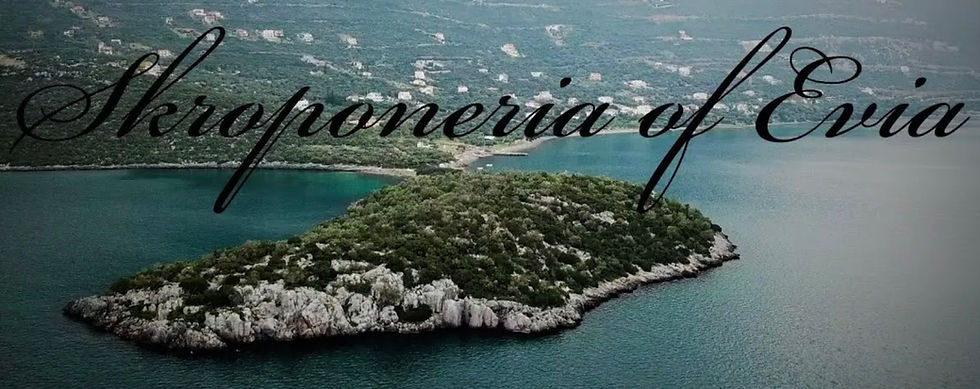Travel : Port of Gerakas, Sparta, Peloponese, Greece. July 4&5/2021
- Lili Naveh
- Jul 5, 2021
- 4 min read
Continuation from the previous post on the Peloponnese (here)
Departing Kyestena Hotel

The 2 days stay at Krysterna was great, from reservation communication with Emilia to check-out , and especially boarding in room 46.
This renovated 17c medieval Manor is a 5+ star hotel situated in a most charming setting.
The two pools on a mountain side, amongst olive trees, orange groves, their own vineyard, and also self grown fresh produce served at the 3 restaurants' cuisine
In addition to reminding me of the Palma's Veldemosa hotel, it also reminded David of EZE - La Chevre d'Or hotel, in France, both Relais Chateau . We will definitely return .

We were sad to leave enchanting Monovasia area (see video)
Prior to crossing the narrow mountain roads to get to Sparta, we paid a short visit to:
Port of Gerkas Fjord

Port of Gerakas is a small quint seaside village, situated by a fjord-like inlet, referred to Pausanias, hidden in the homonyms lagoon, and surrounded by pretty landscape and tranquil water, only 30 minutes drive south from Monemvasia

This "secret" place is a meeting point for migratory birds and other rare species of fauna. The picturesque village of the port with its traditional fish taverns is definitely worth the visit.

Driving toward Sparta the gorgeous vistas of the seaside were left behind, and a slow climb up on the curvy steep narrow roads of the inland's high mountainous ridge brought with it a complete change in the landscape's scenery.

The drive progressed, through few red roof white houses along the winding road through quaint small villages, surrounded by Cyprus, Olive and Fig trees .

The high mountain peaks were dotted with large windmill turbine, looming over deep verdant drops, and narrow canyons.

Driving via Richa, Molai, Vlachiotis and Tripoli , finally got us out of the mountainous area and connected us to the faster Hwy to Sparti,.
Molai

Large swats of stretching agriculturally cultivated valleys became visible, off the road, painted in brown, yellow and bright green colors.

The heat of the afternoon, when we finally arrived, limited our capacity to extensively explore the town's archeological site,
We also moved the visit to Mistras to the following day's early morning hour.

Ancient Sparta's
The site of Ancient Sparta is located close to the modern city center, one of the few Greek towns built with architectural urban space, however disappointingly, there is very little archeologically, to see.
Sparti as it is called in Greece, is in the present time a small (15,000 resident only) insignificant dull town, but with a splendid military city-state past.
Historically named Lacedaemon, it was the ancient capital of the Laconia district of the southeastern Peloponnese,

The city lies on the right bank of the fertile Evrótas Potamós river which has always been the main source, along with the many water springs in the surroundings, for the fertile valley of Laconia,.
The vast rich area has been the brad and butter food supply, as well as a center of clothes dying industry which flourished in the area, along with Silk production.
Olive oil, Oranges, vines and Honey are still major grown products, a source of income.

The scarcity of intact ruins from antiquity around the modern city reflects the austerity of the military oligarchy that ruled the Spartans from the 6th to the 2nd BC.

Ancient Sparti's inhabitants believed that their only purpose in life was to become strong soldiers and protect their homeland with their lives, meaning the bravest death was death on the battlefield.

Our Portuguese friend Luis, in response to my logs shared this comment
"As you know the Peloponnese war was an armed conflict between Athens - the political and civilizational center of the Western world in the 5th century BC ( equivalent to USA of today practicing in expansion through trade) and Sparta - a city-state of militaristic tradition and austere customs (equivalent to Russia practicing expansion via military." aggression)
The decline of Athens marked the rise of Sparta and undid the only possible path for the political unification of the Greek world, and also part of our collective history.

***************************
It was too hot and too late in the afternoon to explore the very near by, medieval guost Castle Town of Mystras - UNESCO World Heritage Site, with its hanging off the cliff amazing structures, so driving up the castle road, just for the breathtaking views, was all we could handle.

Furthermore, arranging for, a professional tour guide, for the next early morning exploration of Mystras, was also a task.
The guide was recommended, at the Entrance Lower Gate (there is also an Upper Gate) by a very helpful site's cashier worker, and more will be told about him, in my next post.
Mystras Village
A small quint popular square with few restaurants and bars, that attracts the visitors
on the way to, or after visiting the medieval castle town.

Food village

Close by to the modern touristic small Mystras village, in the next village named Kafalari, there is a charming hidden "Restaurant court" consisting of 3 very good open-air shaded eating places, less accessible to the incidental tourists, however they are well known to the locals.
Eating there was much more preferable then in the visible popular touristic places.

The 2 recommended and open restaurants in Kafalari, are:
Kafalari Restaurant - where we had a great meal
Koutsgeorgi

The Night was spent at Mystars Palace Hotel Resort &Spa

This beautiful, newly built compound, is conveniently situated off the road between Sparta and Mystars, and offers spacious rooms, 2 pools and lost of green lawns.

The facility was fully occupied prior to the pandemic,. Sadly it was quite empty, due to situation.
Although it is a very nice place, and the view is beautiful, breakfast's food isn't up to par.

To be continued...



Comments